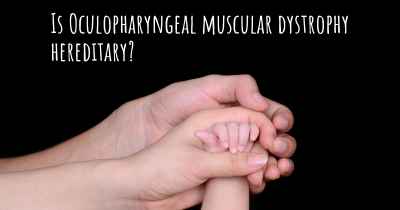What is the history of Oculopharyngeal muscular dystrophy?
When was Oculopharyngeal muscular dystrophy discovered? What is the story of this discovery? Was it coincidence or not?

Oculopharyngeal muscular dystrophy (OPMD) is a rare genetic disorder that primarily affects the muscles of the eyes and throat. It was first described in the medical literature in the late 19th century, but it wasn't until the mid-20th century that researchers began to understand its underlying causes and mechanisms.
Early Observations:
The first documented case of OPMD was reported in 1891 by a French physician named Victor Dubreuil. He described a family in which several members experienced progressive weakness in the muscles controlling eye movement and swallowing. However, it wasn't until the 1920s that the term "oculopharyngeal muscular dystrophy" was coined by another French physician, Victor Raymond.
Genetic Discoveries:
In the 1960s, researchers began to suspect that OPMD had a genetic basis. They observed that the disorder tended to run in families and affected both men and women, suggesting an autosomal dominant inheritance pattern. However, it wasn't until the 1990s that the specific genetic mutation responsible for OPMD was identified.
In 1998, a team of Canadian researchers led by Dr. Bernard Brais discovered that OPMD is caused by an abnormal expansion of a trinucleotide repeat sequence in the PABPN1 gene. This gene provides instructions for producing a protein called poly(A)-binding protein nuclear 1, which is involved in the processing of messenger RNA. The abnormal expansion of the trinucleotide repeat leads to the production of an altered PABPN1 protein that forms clumps within muscle cells, leading to their dysfunction and eventual degeneration.
Prevalence and Geographic Distribution:
OPMD is a relatively rare disorder, with an estimated prevalence of 1 in 100,000 individuals worldwide. However, its prevalence may be higher in certain populations, such as French-Canadians and Bukhara Jews. These populations have a higher frequency of the specific genetic mutation associated with OPMD.
Clinical Features:
OPMD typically manifests in adulthood, usually between the ages of 40 and 60. The initial symptoms often involve drooping of the eyelids (ptosis) and difficulty swallowing (dysphagia). As the disease progresses, individuals may experience weakness and wasting of the muscles in the face, neck, and limbs. Some individuals may also develop weakness in the respiratory muscles, leading to breathing difficulties.
Diagnosis and Management:
The diagnosis of OPMD is usually based on clinical features, family history, and genetic testing. Muscle biopsies may also be performed to confirm the presence of characteristic changes, such as the clumping of abnormal PABPN1 protein.
Currently, there is no cure for OPMD, and treatment focuses on managing symptoms and improving quality of life. This may involve interventions such as eyelid surgery to correct ptosis, speech therapy to address swallowing difficulties, and physical therapy to maintain muscle strength and mobility.
Research and Future Directions:
Since the discovery of the genetic mutation underlying OPMD, researchers have been working to better understand the disease and develop potential treatments. Animal models have been created to study the mechanisms of OPMD and test potential therapeutic approaches.
One promising avenue of research involves the use of gene therapy to deliver normal copies of the PABPN1 gene to affected muscle cells. This approach has shown promising results in preclinical studies and may offer hope for future treatments.
In conclusion, the history of oculopharyngeal muscular dystrophy spans over a century of medical observations and scientific discoveries. From its initial description as a familial disorder affecting eye and throat muscles, to the identification of the genetic mutation responsible for the disease, our understanding of OPMD has significantly advanced. While there is currently no cure, ongoing research offers hope for improved management and potential therapeutic interventions in the future.
Posted May 18, 2017 by Monica 2150
https://academic.oup.com/brain/article/124/3/522/334351#89180107
Posted Feb 22, 2021 by James 2500








